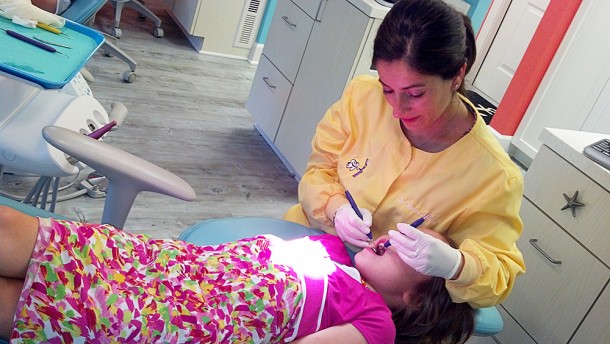
Imagine taking your two-year-old to the dentist and being told she has one, two, even 4 or more cavities. According to the Centers for Disease Control, oral health in the United States has improved for every age group except 2-5 year olds.
When I recently ran across this report from a few years back, I began taking a more hardline approach to the tooth brush tussle with my own youngsters. And I started noticing all the silver in the mouths of kids my daughters’ age.
In the posh, ocean-themed interior of Hillsboro Pediatric Dentistry, six-year-old Hannah learns that she must have yet another tooth pulled. A pretty girl with long brown hair and sparkly boots, she quietly takes the news, just wanting the pain to stop.
This first-grader has already had 2 molars pulled, 2 teeth capped, and 2 cavities filled. Her mom thinks the problems started with prolonged breastfeeding:
She would nurse every night and fall asleep till she was 18 months old and I didn’t think about it was sugar and sitting on her gums and her teeth.
Hannah’s first cavities appeared when she was just two and a half. She’s not alone. According to the CDC report that lead me here, 28% percent of toddlers in the United States have decayed teeth.

Pediatric dentists take x-rays of children’s mouths using smaller mouth guard plates. This x-ray shows a child’s erupting teeth. X-rays are also used to diagnose bone disease, evaluate an injury or plan orthodontic treatment. Image: WPLN/Adrienne Outlaw
Across Income and Education
What’s really surprising is that more money doesn’t necessarily mean better teeth, says Dr. Caldwell. She runs two dental practices in Nashville, treating a mostly immigrant population in Nippers Corner and a generally well-off and well-educated clientele at her practice near Vanderbilt University.
She says she assumed these issues arose mostly where income levels led shoppers to “the cheapest, most cavity-prone foods” but was surprised to find them “even in the educated crowd.”
Some Unexpected Culprits
Caldwell says parents often think they’re doing a good job. But bottled water, organic raisins and constant juice sipping can come with its own downside – not enough fluoride and too much sugar.
“Sugar bugs” is Caldwell’s gentle name for the residue from sticky snacks like raisins and fruit strips which hang on even after a good brushing. Treat raisins like candy, she cautions. Don’t give a bottle at bedtime. Avoid even diet soda – the carbonation reeks havoc on the mouth.
Six-year-old Hannah’s mom says that if she had had the right information she’d been more proactive, her daughter would’ve had more days in school and she wouldn’t be in such pain. “Used to be baby teeth, don’t worry about it,” she says, “but now it’s her molars. She can’t chew.”:
For decades now the American Academy of Pediatric Dentistry has recommended that children visit the dentist by age one, but most parents still wait until their child is 3.
Barring an early dental visit and minding the sugar, Dr. Caldwell says the golden rule still follows – brush twice a day.

A dental assistant cleans the mouth of a three year old here for her first trip to the dentist. Image: WPN/Adrienne Outlaw

